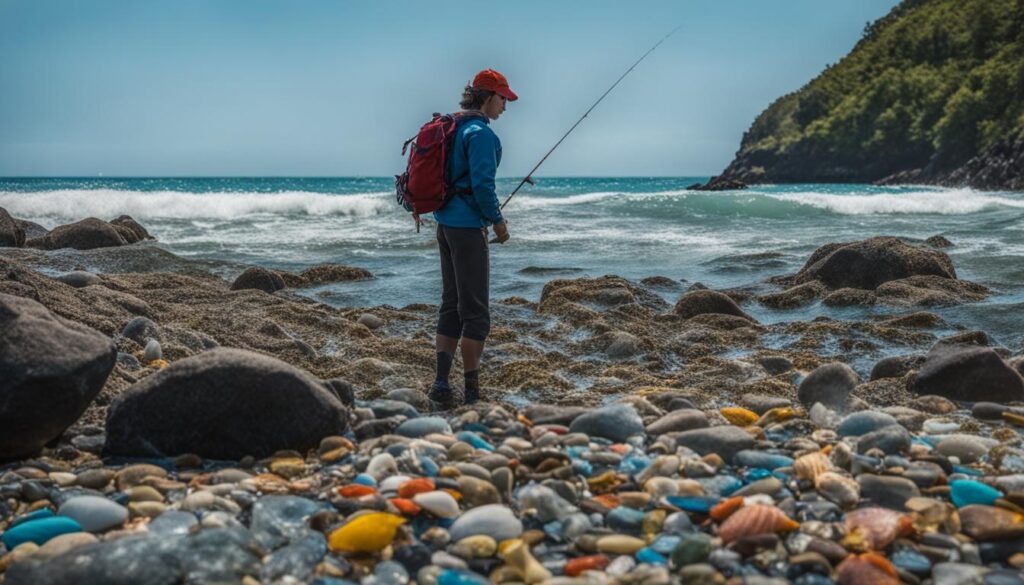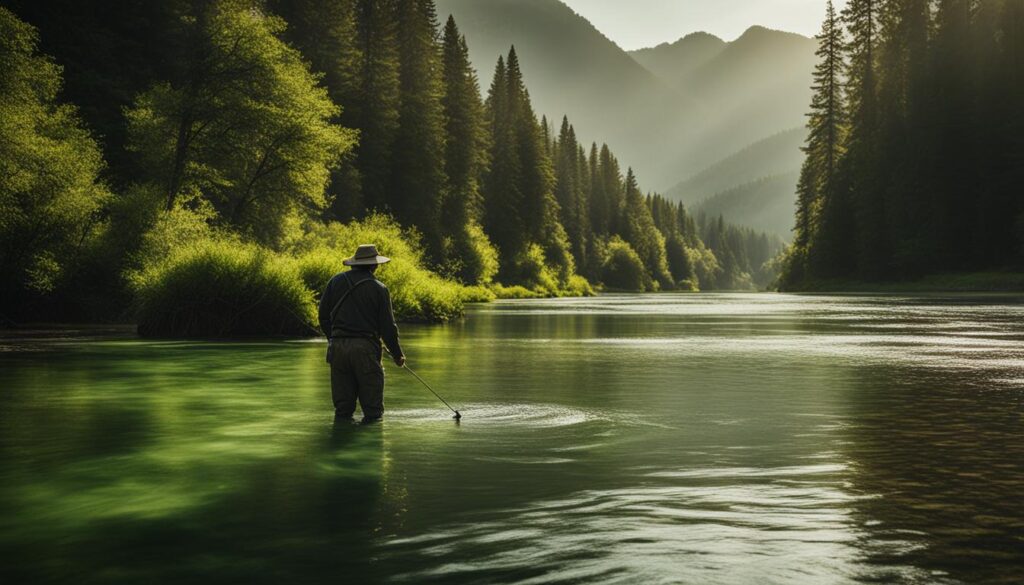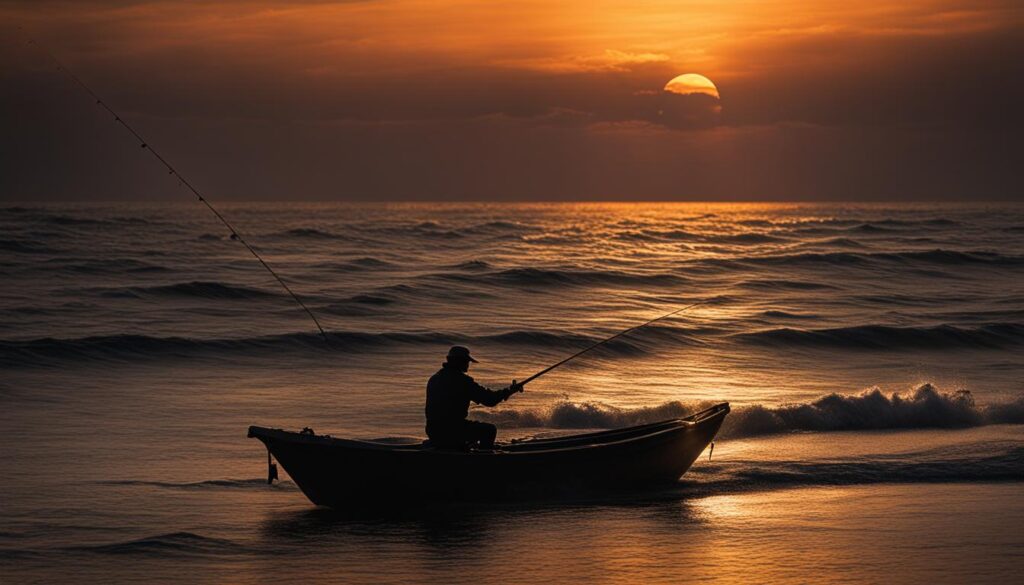We may earn money or products from the companies mentioned in this post.
Handline fishing is a traditional method that has been used for centuries. It involves using a single fishing line, held by hand, with a baited hook attached to the end. Handline fishing is a great option for those who enjoy the simplicity of fishing and want to experience a more traditional approach.
In this section, we will guide you through the different handline fishing methods and techniques that you can use to become a master at this traditional fishing technique. From how to choose the right handline fishing equipment to advanced handline fishing techniques, we’ll cover everything you need to know.
Key Takeaways:
- Handline fishing is a traditional fishing technique that involves using a single fishing line held by hand.
- Mastering handline fishing methods can enhance your connection to the sport and increase your chances of success on the water.
- Choosing the right handline fishing equipment and fishing spot is essential to your success.
- There are various handline fishing techniques, from basic to advanced, that you can use to catch fish successfully.
- Following safety precautions while handline fishing is crucial to ensure a fun and secure experience.
Understanding Handline Fishing Equipment
If you’re new to handline fishing, it’s important to know about the equipment you’ll need to get started. Below is a breakdown of the essential gear that every handline angler should have:
| Equipment | Description |
|---|---|
| Handline | A handline is a length of strong fishing line that is held by hand. It is typically made of braided nylon or Dacron and can range from 100 to over 500 feet in length. |
| Reel | While handline fishing does not require a reel, it can be helpful to have one for storing and managing your line. |
| Hook | A hook is used to catch the fish and should be chosen based on the size of the fish you are targeting. Hooks come in various shapes, sizes, and styles, including circle hooks, J-hooks, and treble hooks. |
| Sinker | A sinker is used to weigh down your line so that your bait sinks to the desired depth. Sinkers come in a variety of shapes and sizes, including split shot sinkers and egg sinkers. |
| Bait | The type of bait you use will depend on the fish you are targeting. Some popular handline fishing baits include live bait, cut bait, and artificial lures. |
Other handline fishing gear that you might want to consider includes gloves to protect your hands from the fishing line, a fishing knife for cutting bait and filleting fish, and a fishing net to help you land your catch.
When choosing handline fishing gear, it’s important to select high-quality, durable equipment that will stand up to the rigors of saltwater fishing.
Now that you know what equipment you need, it’s time to learn how to use it. In the next section, we’ll provide step-by-step instructions on how to handline fish.
How to Handline Fish: A Step-by-Step Guide
Handline fishing is a simple and effective technique that has been used for centuries. To get started with handline fishing, follow these step-by-step instructions.
- Choose the right location: Start by choosing a location with calm waters and plenty of fish. Look for areas with structures like rocks or piers that offer cover for fish.
- Prepare your equipment: Make sure your handline is rigged and ready to go. Tie on your hook, attach your sinker, and add bait if desired.
- Cast your line: Hold the handline in one hand and swing it behind you. Then, swing it forward and release the line as you aim for your desired spot in the water.
- Let the line sink: Allow the line to sink to the desired depth, counting as you do so to ensure consistency.
- Reel it in: Once you’ve reached the desired depth, give your handline a gentle tug to attract fish and then wait. If you don’t get a bite, slowly reel in the line and repeat the process in a different location.
Remember to stay alert and keep an eye on your line for any movement or tension. As you gain experience, you’ll learn different techniques and tricks that will help you catch more fish using a handline.
Handline Fishing Tips for Beginners
- Start with a lightweight handline and gradually work your way up to heavier equipment.
- Use live bait when possible, as it tends to be more effective than artificial lures.
- Try different techniques like jigging or slow trolling to see what works best in your location.
- Stay patient and don’t give up if you don’t catch fish right away. It takes practice and persistence to become a successful handline fisherman.
Advanced Handline Fishing Techniques
If you have mastered the basics of handline fishing, it’s time to explore advanced techniques that can help you catch bigger and more challenging fish. Advanced handline fishing requires more skill, patience, and knowledge of fish behavior. Below, we’ll discuss some of the top advanced handline fishing techniques to help you improve your chances of success in the water.
Jigging
Jigging is a popular technique used by expert handline anglers to catch species such as tuna, amberjack, and kingfish. This technique involves lowering a weighted lure to the bottom of the water and then rapidly lifting and lowering the lure to create a jerking motion that mimics a wounded baitfish. Jigging can be physically demanding, but the reward is often worth the effort.
Trolling
Trolling is another advanced handline fishing technique that involves dragging a lure or bait behind a moving boat. This technique is often used for catching species such as mahi-mahi, wahoo, and sailfish. Trolling requires a boat and a good understanding of the species, environment, and weather conditions.
Bottom Bouncing
Bottom bouncing is a technique used to catch fish that are close to the bottom of the water. It involves using a weighted lure that bounces along the bottom, mimicking the movement of a baitfish. This technique is often used to catch species such as halibut, cod, and grouper.
Chumming
Chumming is a technique used to attract fish to a specific location by creating a slick of ground-up bait that is thrown into the water. This technique can be highly effective for catching fish such as salmon, tuna, and sharks. Chumming requires careful preparation and timing, and it’s important to use the right type and amount of bait.
Drift Fishing
Drift fishing is a technique used to catch fish that are swimming on or near the surface of the water. It involves drifting along with the current while dragging a bait or lure behind the boat. This technique is often used for catching species such as trout, striped bass, and bluefish.
These are just a few of the many advanced handline fishing techniques that can help you improve your skills and catch more fish. Remember, becoming an expert angler takes time, effort, and lots of practice. Keep learning, experimenting with different techniques, and pushing yourself to improve, and you’ll soon be reeling in the big catch with your handline.
Tips and Tricks for Successful Handline Fishing
Handline fishing requires some techniques that can help you increase your chances of catching fish. Here are some handline fishing tips:
- Choose the right bait: Handline fishing requires live bait. Different fish species prefer different baits. Use bait that is readily available in the fishing spot and is also preferred by the target fish species.
- Pay attention to the weather: The weather can affect fish behavior. Sunny weather can drive fish into deeper waters where it’s cooler, while overcast weather can bring fish up to the surface.
- Be patient: Handline fishing requires patience, especially when waiting for the fish to bite. Sometimes it may take longer or require multiple attempts. Don’t give up and keep trying.
- Use the right technique: Different fish species require different handline fishing techniques. Experiment with different techniques to see which one works best for the target fish species.
- Locate the fish: Look for signs of fish, such as jumping, bubbles or ripples in the water. This can help you identify where fish are located, increasing your chances of a successful catch.
“Patience is key for handline fishing. Persistence and experimenting with different techniques can lead to a successful catch.”
Safety Precautions for Handline Fishing
Handline fishing can provide an exciting and enjoyable experience, but it’s essential to consider safety when engaging in this activity. Here are some basic safety precautions to ensure you have a safe and pleasant time handline fishing.
Wear Appropriate Clothing
When fishing, it’s important to dress appropriately. Wear clothes that will protect you from the sun, wind, and rain, and wear shoes with good grip to avoid slipping on wet surfaces.
Use Protective Gear
Always wear a life jacket or personal flotation device when handline fishing, especially if you’re fishing from a boat. If you’re fishing in an area with rocks or other hazards, wear protective gloves to prevent cuts and scrapes.
Be Aware of Your Surroundings
It’s important to be aware of your surroundings while handline fishing. Understand the weather and water conditions, and keep a lookout for other boats and watercraft in the area. Avoid fishing in areas with strong currents or undertows.
Handle Fish with Care
When handling fish, be sure to use caution. Fish can be slippery and have sharp fins, so handle them with care to avoid injury. Use pliers or a de-hooking tool to remove hooks safely and gently release the fish back into the water.
Bring a First Aid Kit
It’s a good idea to bring a small first aid kit with you while handline fishing. This should include items such as band-aids, antiseptic wipes, and pain relievers in case of minor injuries.
Practice Responsible Fishing
Be a responsible angler and follow local fishing regulations. Respect the environment and keep it clean by properly disposing of waste and not leaving any fishing gear behind.
By following these safety precautions, you can ensure a fun and safe handline fishing experience.
Choosing the Right Handline Fishing Spot
Handline fishing requires some planning and preparation to choose the perfect spot to fish. Experienced anglers will tell you that the key to a successful catch is to find the right spot. Here are some tips to help you choose the right spot for handline fishing:
Identify Suitable Locations
When looking for a suitable location, you should consider factors such as water depth, currents, and fish species. Choose a location where the water is deep enough to hold the fish species you are targeting. Also, consider the current as fish tend to swim with the current, making it easier to catch them.
Understand the Topography of the Area
Knowing the topography of the area you want to fish is important. Check out the area either by foot or using a map. It will help you identify structures such as underwater rocks and submerged logs that can act as hiding spots for fish. It’s also important to note that fish prefer protected areas like coves, inlets, and shorelines.
Check the Weather Conditions
Weather conditions also play a significant role in where fish congregate. During a sunny day, fish tend to go deeper in the water or stay near structures to avoid the heat. On the other hand, during cloudy or cooler days, fish tend to move to shallow waters. So it’s important to check the weather forecast before heading out.
Fishing Guide
| Fish Species | Location |
|---|---|
| Barracuda | Coastal waters, reefs, and rocky areas |
| Red Snapper | Underwater rock formations, wrecks, and offshore reefs |
| Tarpon | Estuaries, near structures, and river mouths |
| Mahi Mahi | Near floating objects, seaweed, and wrecks |
Always follow safety guidelines and consult with local authorities before heading out to fish.
Conclusion
Handline fishing is more than just a traditional technique; it is a captivating way of exploring the water and connecting with your surroundings. Whether you are a novice or an expert angler, mastering handline fishing methods can enhance your fishing experience and increase your chances of success on the water. By understanding the equipment, following our step-by-step guide, exploring advanced techniques, and using our tips and tricks, you can take your handline fishing skills to the next level and become a true master of the craft.
As you embark on your handline fishing journey, keep in mind the importance of safety. Always take proper precautions to ensure a secure and enjoyable experience. By choosing the right fishing spot, identifying suitable locations, and taking into account factors such as water depth, currents, and fish species, you can increase your chances of catching a fish and enjoy the thrill of the catch.
Handline fishing methods have been handed down from generation to generation, and it is up to us to preserve this traditional technique for future generations. By following our guide and immersing yourself in the art of handline fishing, you can contribute to its ongoing legacy and discover a unique and rewarding fishing experience.
FAQ
What is handline fishing?
Handline fishing is a traditional fishing technique that involves using a single fishing line with a baited hook, sinker, and no reel. It requires the angler to manually cast the line, control the depth, and reel in the catch using their hands.
What equipment do I need for handline fishing?
The essential equipment for handline fishing includes a handline, hooks of various sizes, sinkers to add weight, and a tackle box to keep everything organized. Additional gear such as gloves, a fillet knife, and a bucket for keeping the catch may also be useful.
How do I handline fish?
To handline fish, start by attaching your desired bait to the hook. Hold the handline in one hand and swing it in a circular motion to gain momentum. Release the line at the desired spot, allowing it to sink to the desired depth. Once you feel a bite, quickly jerk the line upwards to set the hook, and then use your hands to reel in the fish.
Are there advanced techniques for handline fishing?
Yes, there are advanced techniques for handline fishing. Some examples include jigging, which involves making the line move up and down to attract fish, and trolling, which involves dragging the line behind a moving boat to cover a larger area. These techniques require practice and skill, but they can be highly effective.
What are some tips for successful handline fishing?
To increase your chances of success, choose the right fishing spot by considering factors such as water depth, currents, and the presence of fish species. Additionally, using live bait or lures that mimic the local prey can attract more fish. Patience, observation, and adjusting your technique based on the conditions can also improve your success rate.
How can I practice handline fishing safely?
Safety is important while handline fishing. Always wear appropriate clothing, including a life jacket if fishing from a boat. Be mindful of your surroundings, especially when casting the line, to avoid injury. It’s also essential to have basic knowledge of swimming and to be aware of any local fishing regulations or restrictions.
How do I choose the right handline fishing spot?
When choosing a handline fishing spot, consider factors such as water depth, currents, and the specific fish species you’re targeting. Look for areas with structure, such as reefs, rocky outcrops, or underwater vegetation, as these can attract fish. Additionally, researching local fishing reports or talking to other anglers can provide valuable insight into productive fishing spots.
What are the benefits of handline fishing?
Handline fishing offers a unique fishing experience that allows you to connect more closely with the fish and the water. It is a versatile technique that can be practiced in various fishing environments, from freshwater lakes to saltwater coastal areas. Mastering handline fishing methods can enhance your skills as an angler and potentially increase your chances of catching fish.
Affiliate Disclosure: This post may contain affiliate links. If you purchase through our link, we may receive a small commission, but at no additional cost to you. For more information, please see our Disclosure statement.



